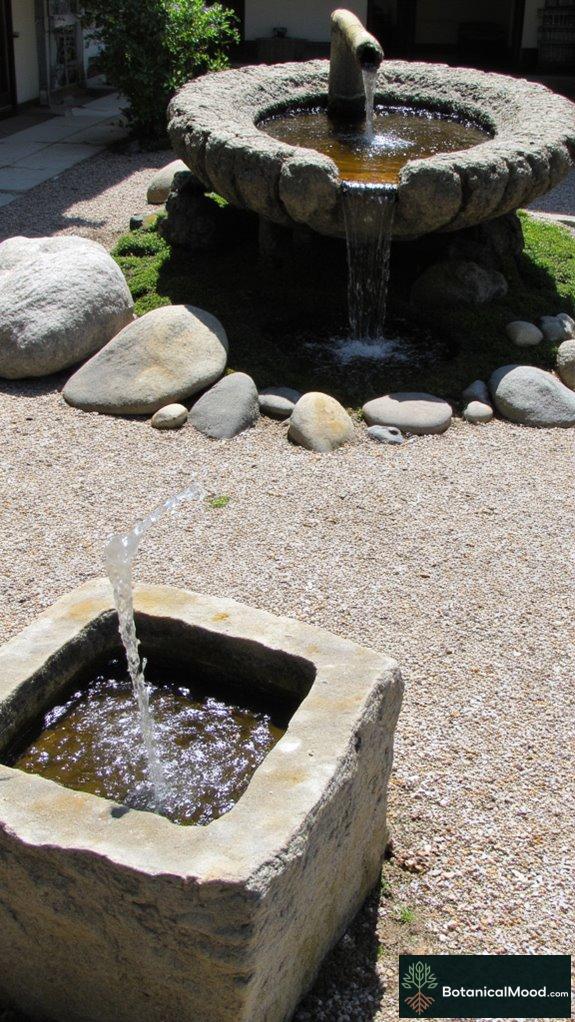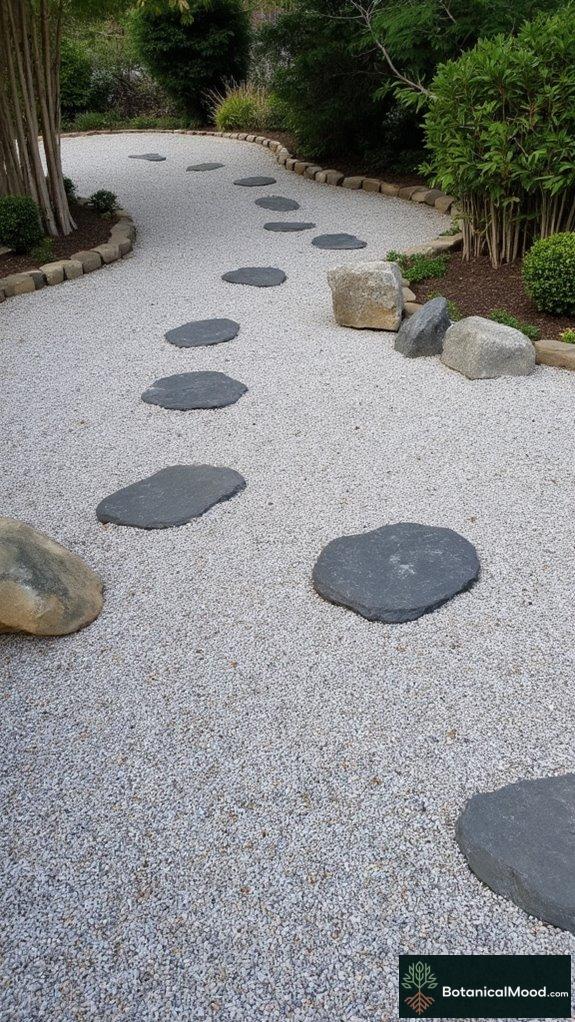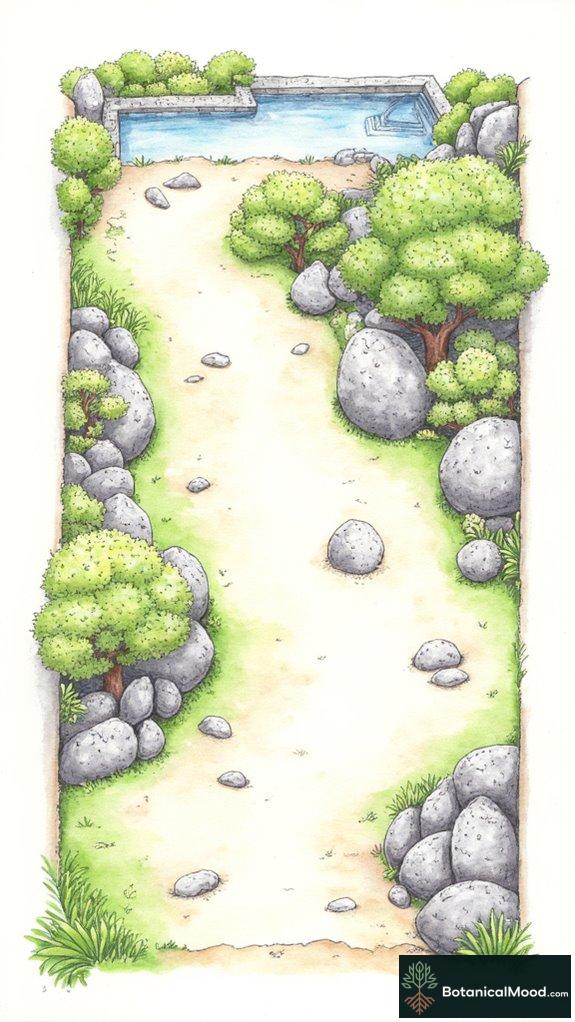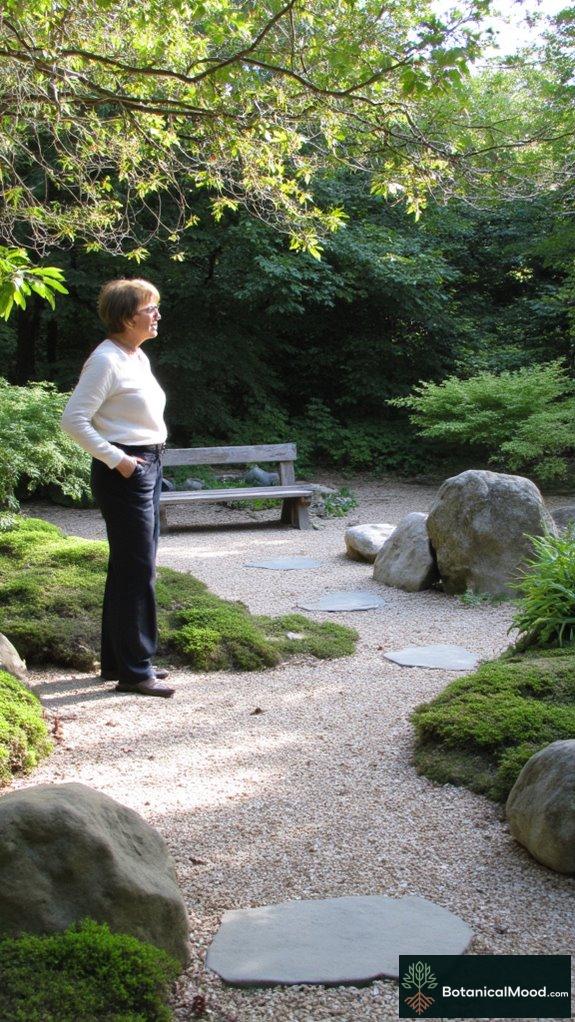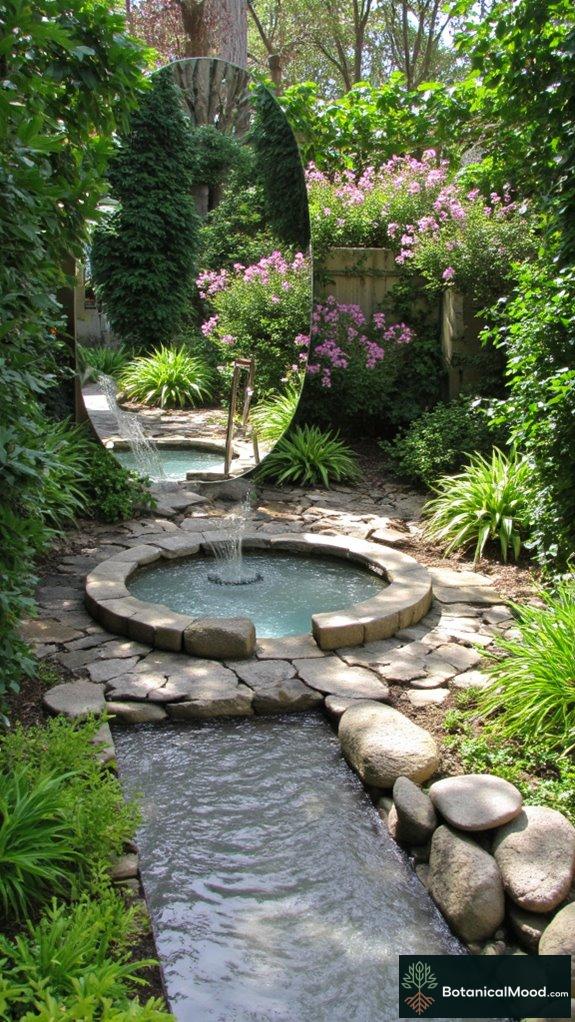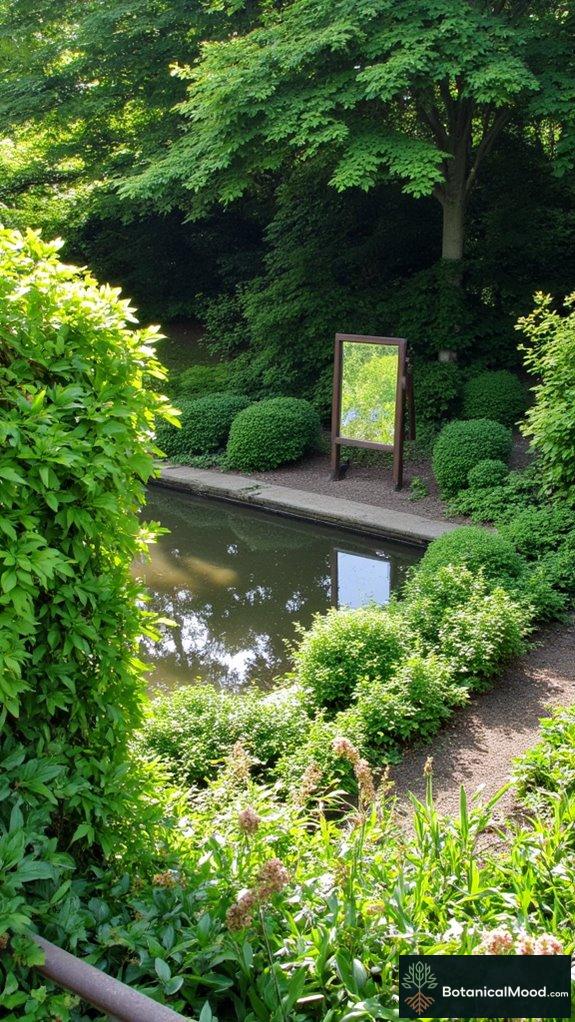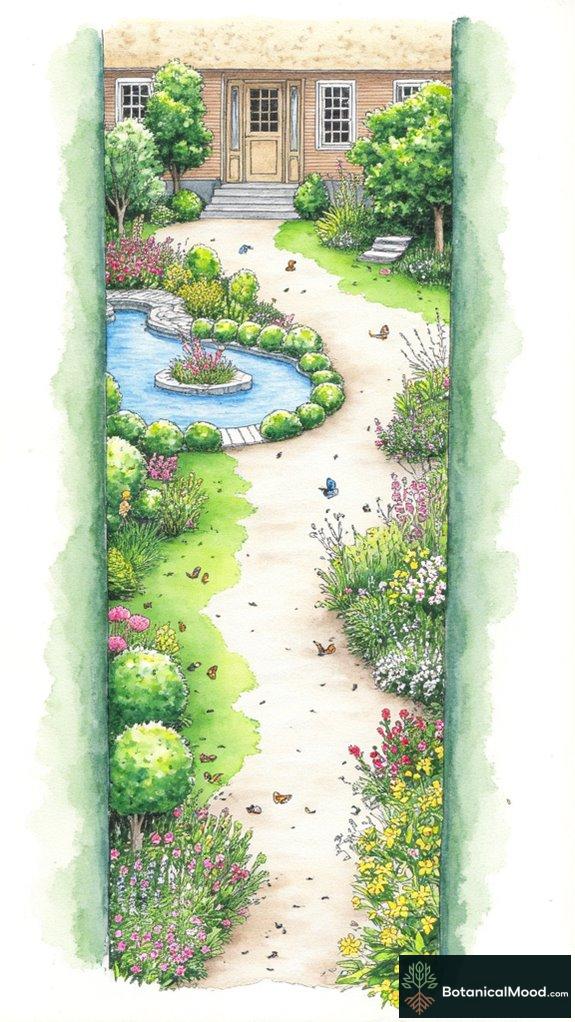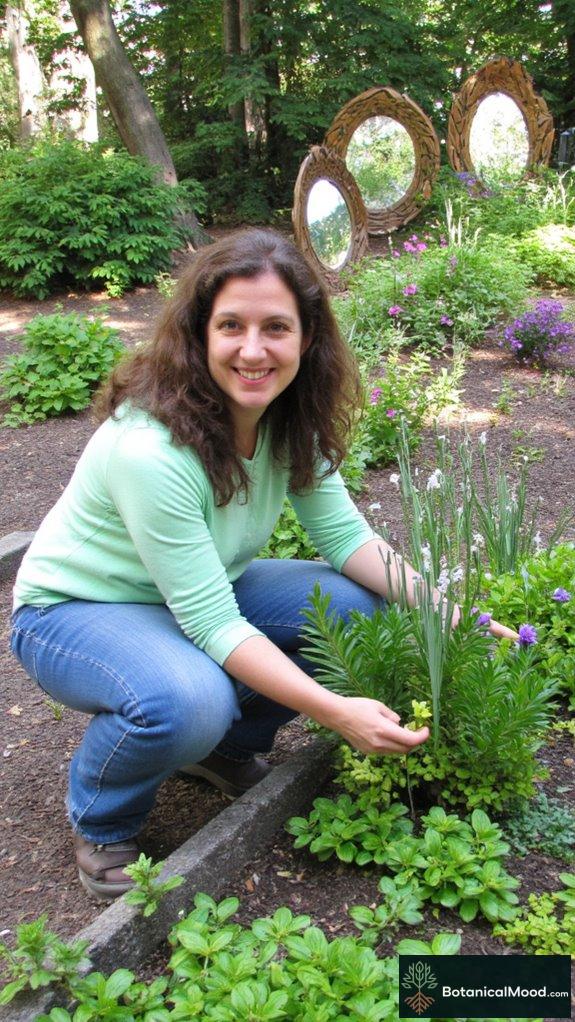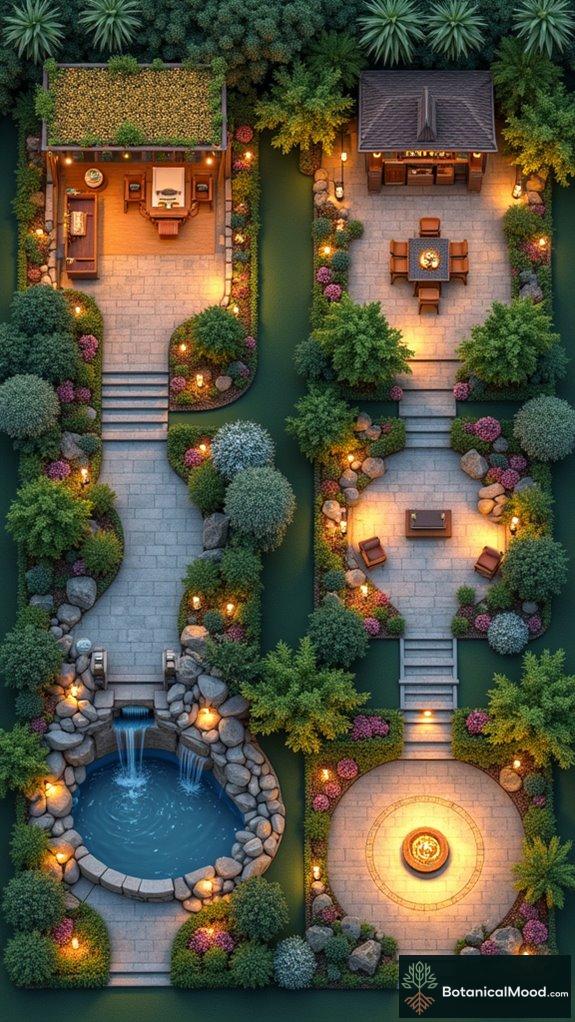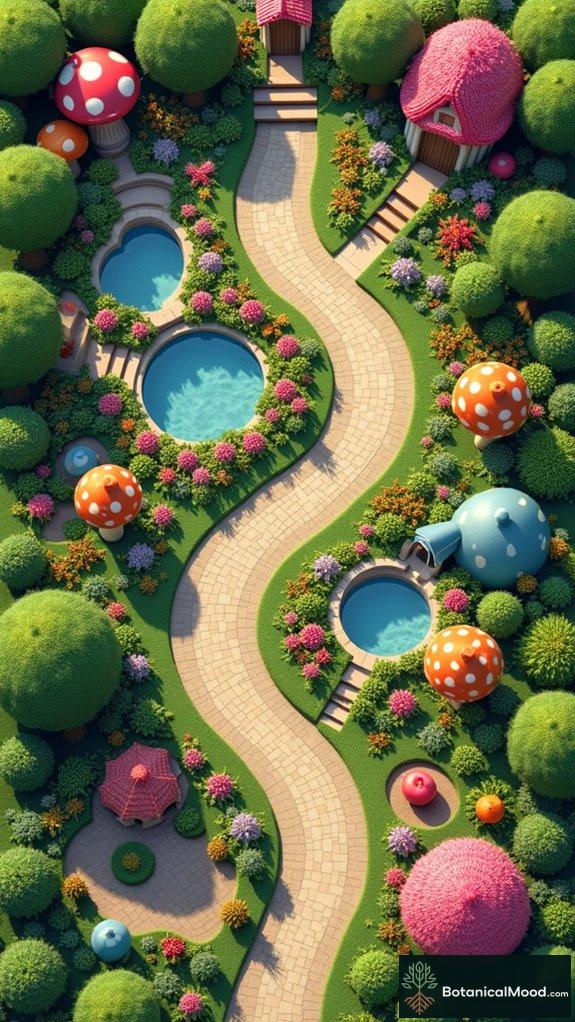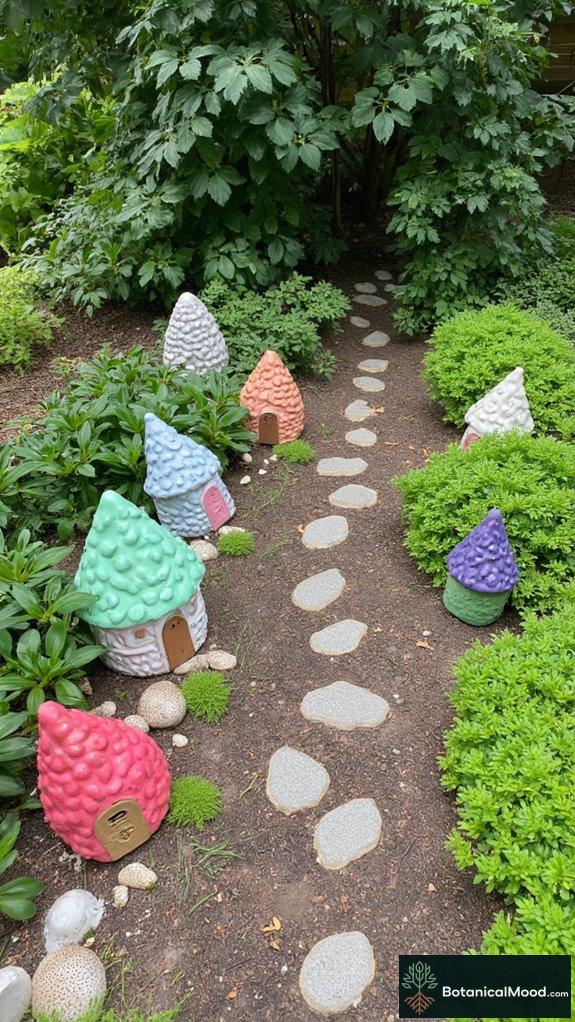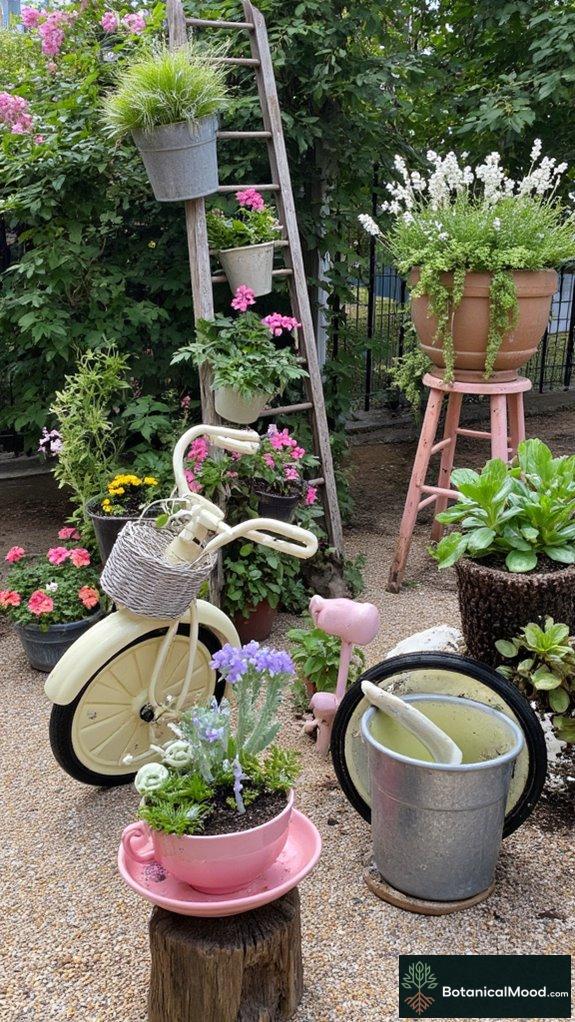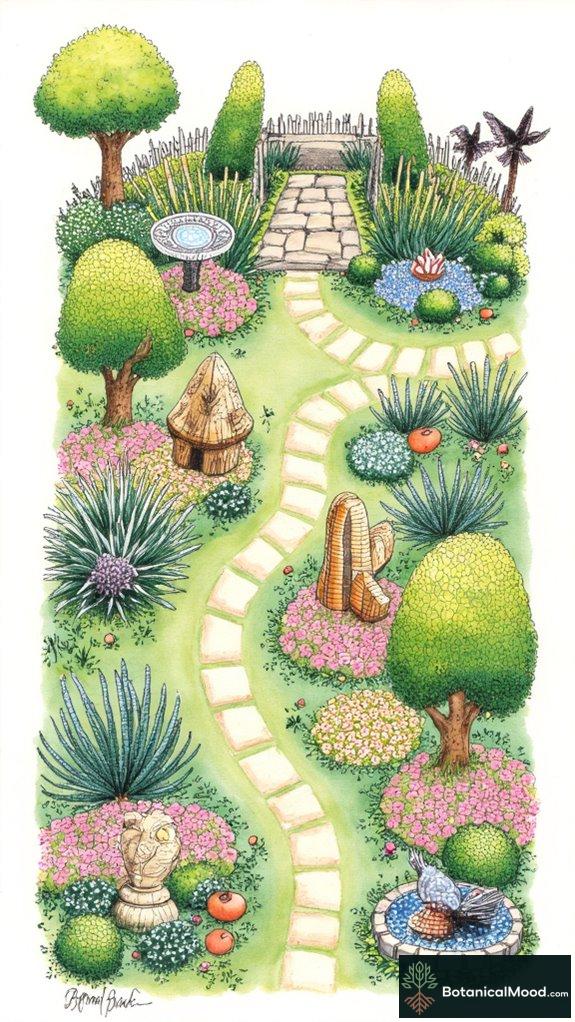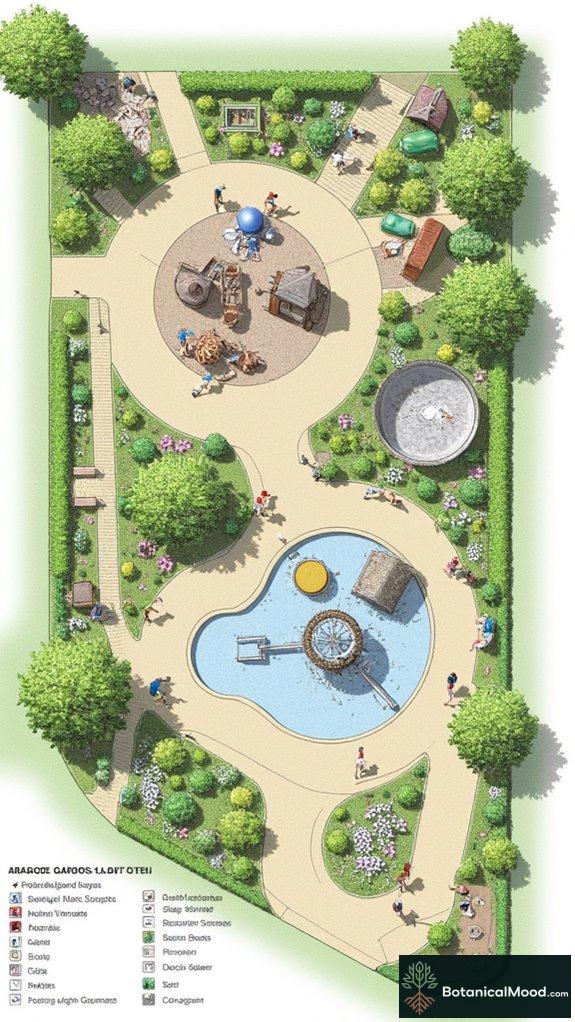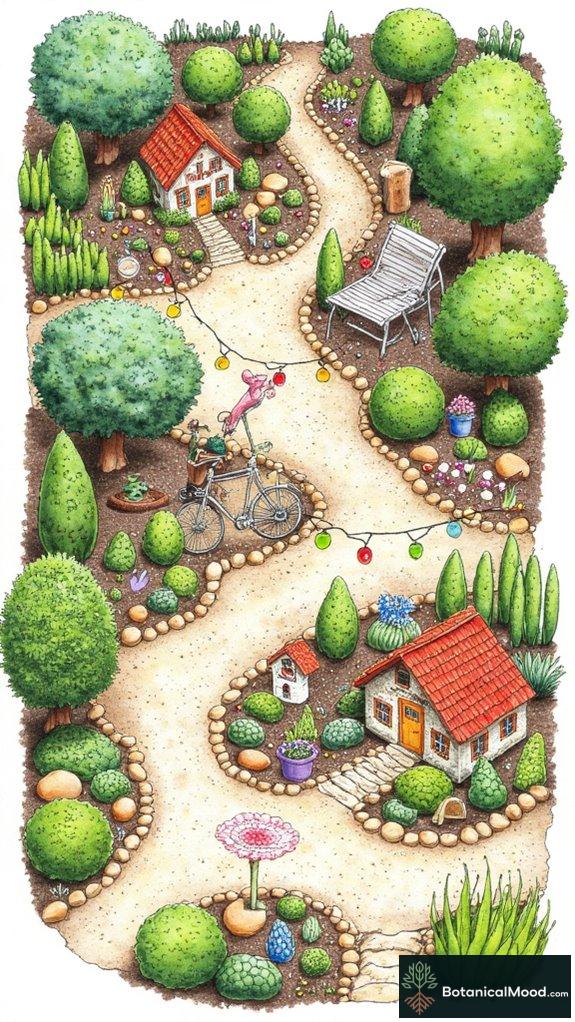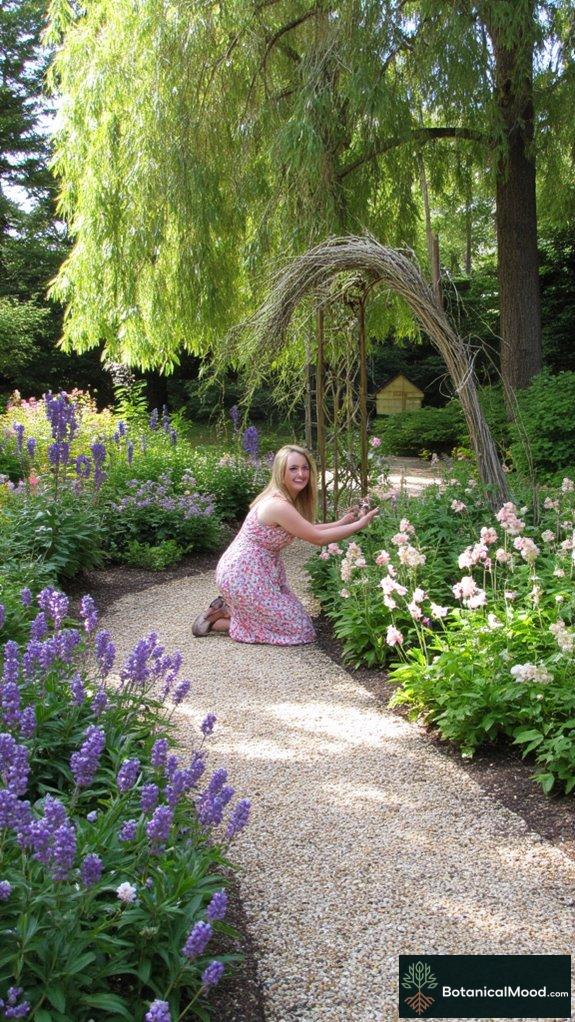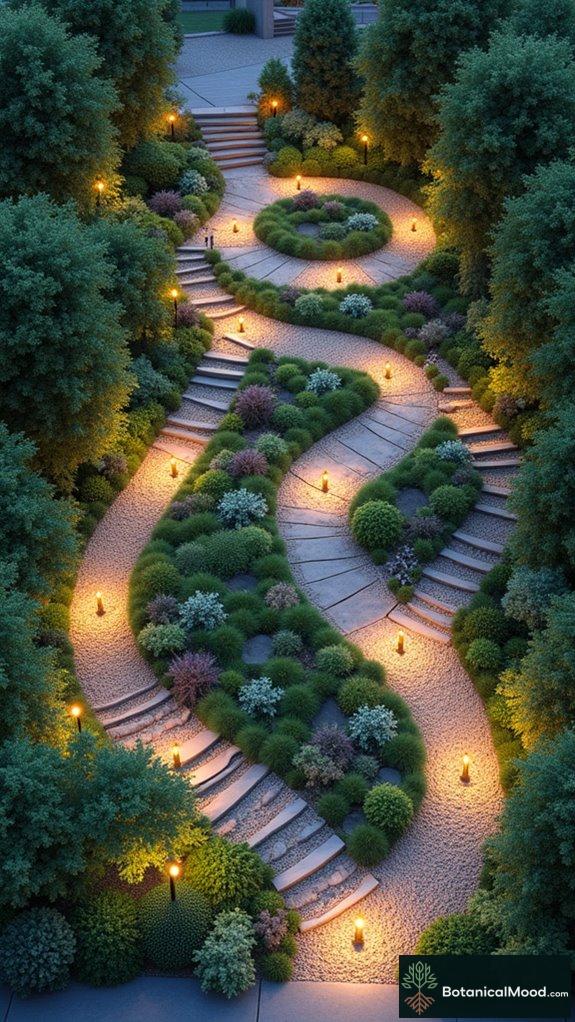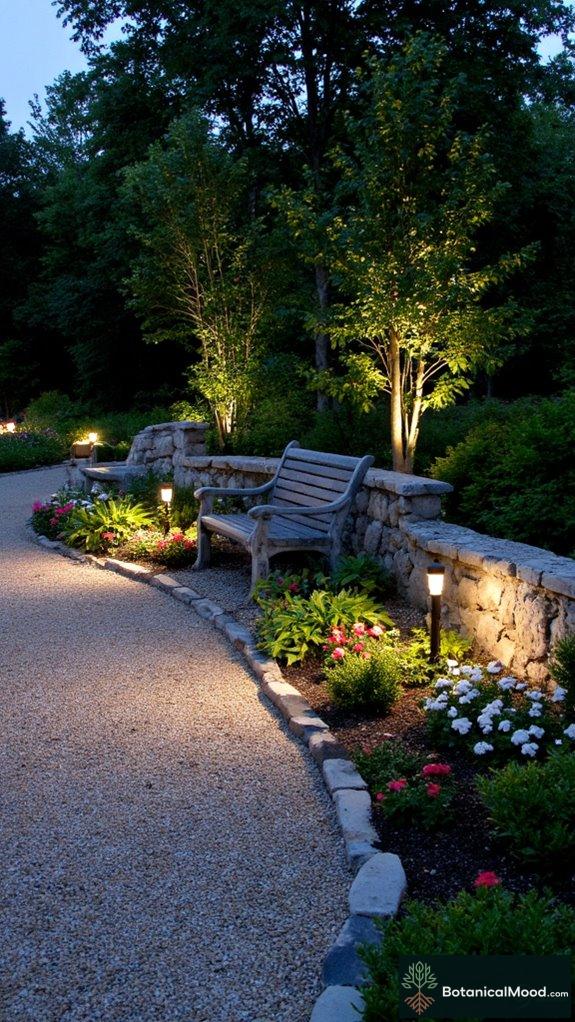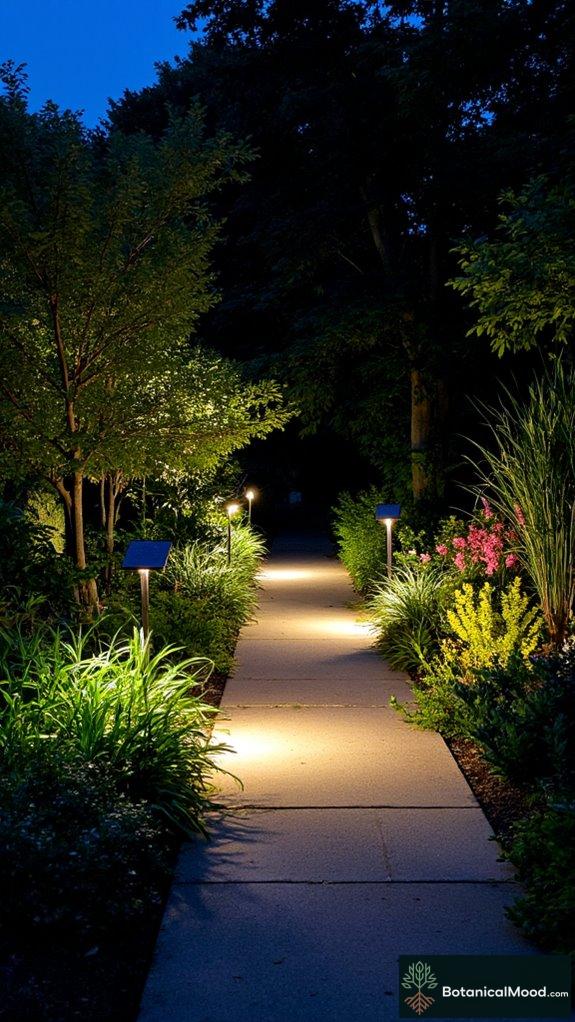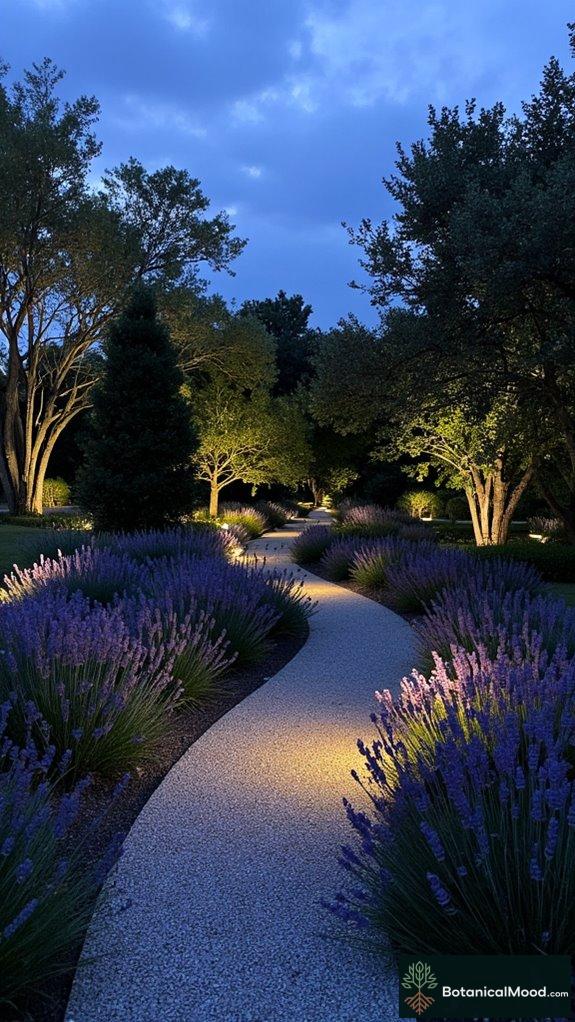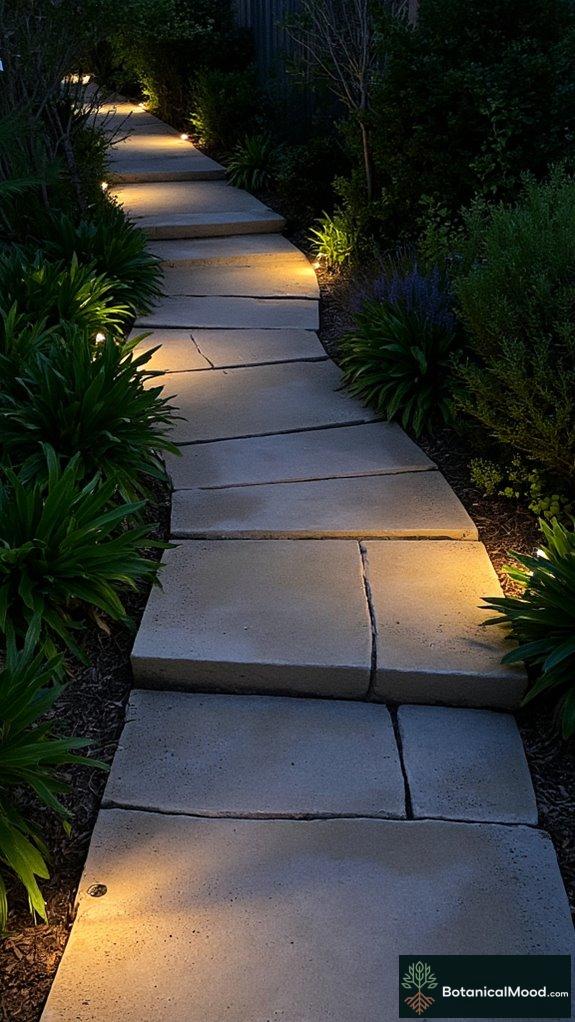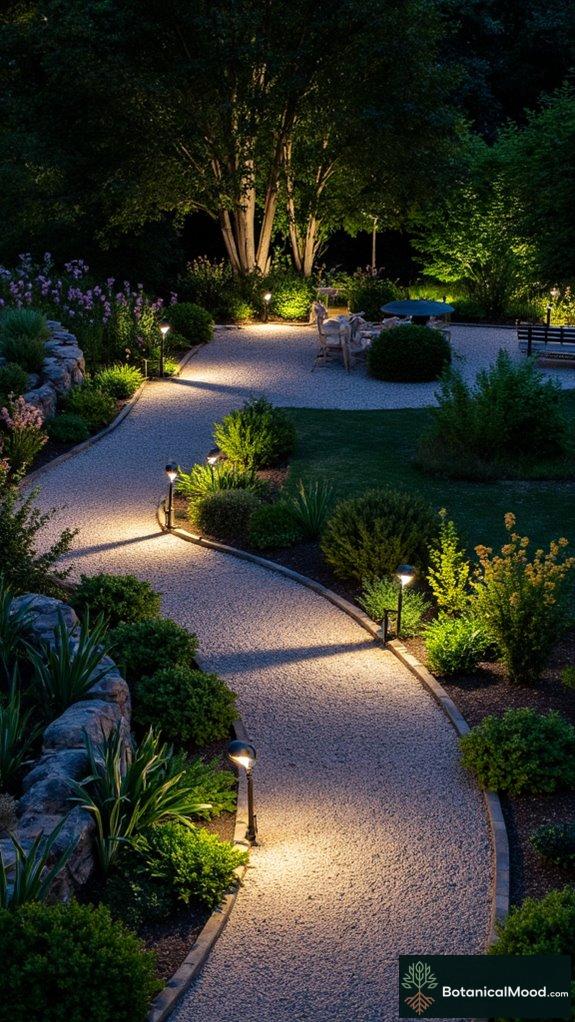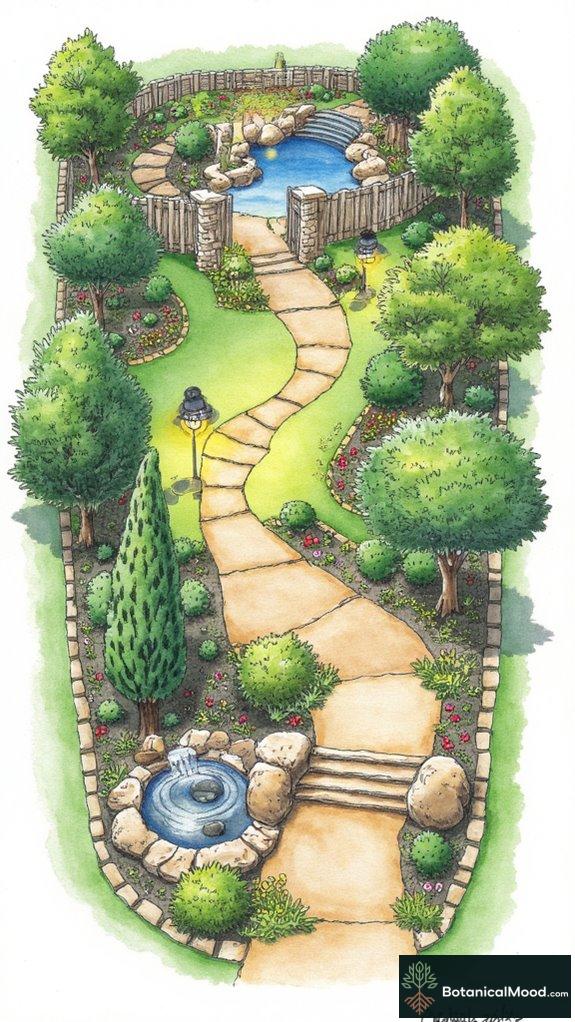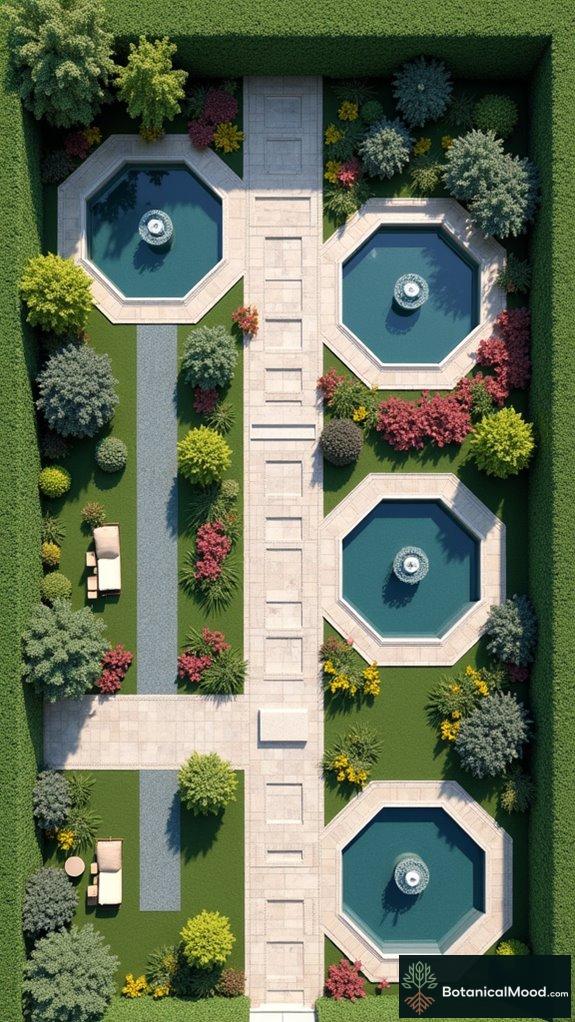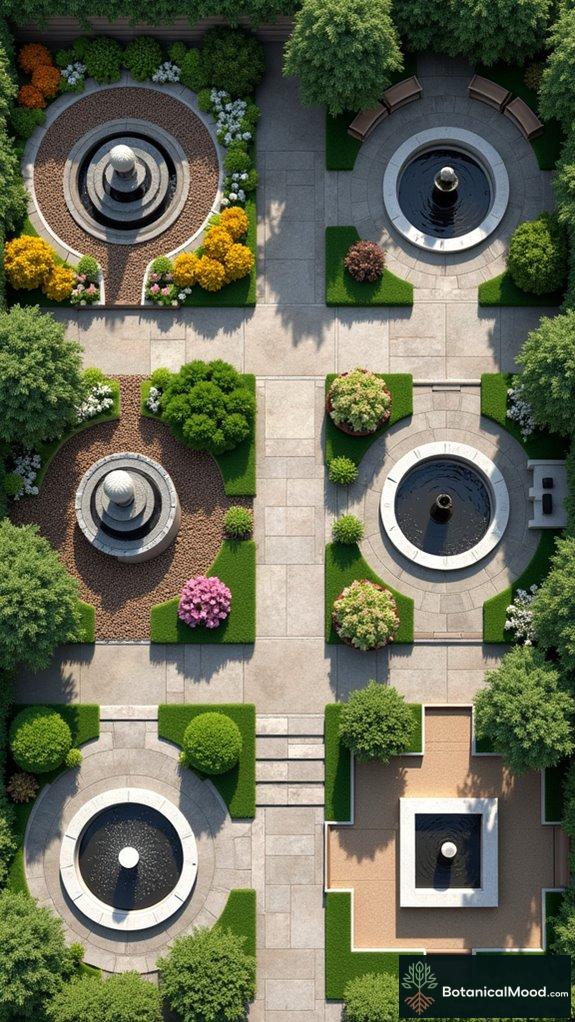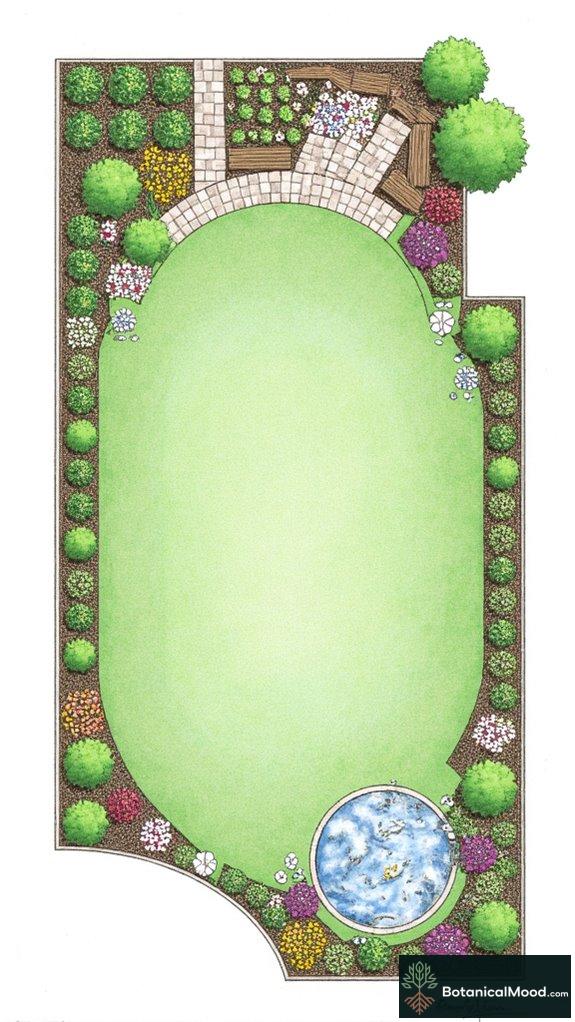You know, just when I think I’ve seen it all in garden design, 2025 throws a curveball.
Lush vertical gardens? Genius! They turn dreary walls into a breathing masterpiece while getting rid of my not-so-lovely apartment air.
And don’t even get me started on smart irrigation systems. This tech-obsessed wonder ensures I barely have to think about watering!
I fondly remember turning my sparse backyard into a cozy fire pit hangout. Nothing like gathering friends around a flickering flame and pretending summer lasts forever.
Ever tried navigating innovative planting patterns? Talk about a fun challenge. But hey, if I can do it, so can you.
Transform Your Outdoor Space: My Vertical Garden Journey
A couple of years ago, I decided my balcony needed a makeover. I dutifully installed a vertical garden filled with herbs and succulents. Not just for aesthetics, mind you! Who doesn’t want fresh basil at hand for their unexpected Saturday pasta night?
Friends were impressed—at least that’s what I tell myself—and every time I watered my plants, I felt a rush of joy as nature crept into my urban life.
Consider layering colors and textures in your own design! Experiment with plant varieties like ferns and flowering vines. Trust me; it’s more than just planting. It’s creating a sanctuary!
Quick Takeaways
- Sustainable Materials: The use of reclaimed wood and bamboo is trending for eco-friendly garden designs, promoting sustainability and unique aesthetics.
- Biodiverse Layouts: Gardens that mimic natural meadows with native plants are gaining popularity for supporting local ecosystems and attracting pollinators.
- Multifunctional Spaces: Outdoor areas designed for relaxation and social gatherings, like dining zones and meditation spots, are essential for enhancing garden utility.
- Vertical Gardens: Incorporating vertical gardens transforms urban spaces, improving air quality and aesthetic appeal while fostering biodiversity in limited areas.
- Smart Irrigation Systems: Advanced irrigation technology is trending for efficiency, conserving water while ensuring optimal plant growth in sustainable gardens.
Vertical Gardens: Innovative Green Walls

What makes vertical gardens so enchanting?
Well, envision transforming your dull, brick wall into a lush, green oasis – it’s like giving your home a plant hug! The vertical garden benefits are abundant, not only adding aesthetic appeal but also improving air quality and reducing noise. These vertical setups can feature cactus and succulent walls, which thrive in bright sunlight and require minimal upkeep. Moreover, vertical gardening can maximize small urban spaces, allowing city dwellers to enjoy greenery even in limited areas.
Now, don’t worry about the vertical garden maintenance; with modular planting systems and low-maintenance plants like succulents, you can channel your inner gardener without becoming a full-time plant parent.
Plus, these green walls can support biodiversity, bringing urban wildlife to your doorstep while you sip coffee on your sunny balcony.
I created this website, Botanical Mood, to inspire a love for these vibrant structures, merging beauty, design, and care – all wrapped up in greenery!
Smart Irrigation Systems: Technology in Your Garden

Vertical gardens not only transform empty walls into vibrant displays of greenery but also lead us to reflect on the broader environment of garden technology, particularly smart irrigation systems that enhance our gardening experience.
Imagine commanding your garden from your phone, because smart watering is a thing! These nifty systems use moisture sensors to determine when to water, saving water and your sanity. They adapt to real-time weather and even let you control your garden from anywhere. By implementing smart visual strategies, you can further optimize your water-wise practices for a thriving garden.
| Feature | Benefit | Example |
|---|---|---|
| Adaptive Scheduling | Dynamic watering adjustments | Rachio |
| Remote Monitoring | Control from anywhere | Orbit B-Hyve |
| Water Conservation | Save 50% more water | RainMachine |
With these tools, you’ll have a garden that thrives while you sit back and enjoy!
Biophilic Design: Embracing Nature in Urban Spaces

As urban areas continue to expand, we can find ourselves increasingly disconnected from nature, which is why biophilic design is emerging as an essential concept in enhancing our built environments.
Envision lush green walls that not only look stunning but also scrub the air cleaner than a car wash!
By using organic materials like wood and stone, these spaces invite a sweet nature connection while making our urban wildlife feel right at home.
Multi-functional areas serve as napping spots or collaboration hubs, all while giving us the calming effects of nature.
Who knew that including some plants and playful water features could actually lift our spirits? It’s like bringing a bit of Eden into the concrete jungle—definitely a piece of the reason I created Botanical Mood!
Fire Pits and Outdoor Heating: Cozy Gatherings Year-Round

Cozy gatherings around a fire pit can transform any outdoor space into an inviting retreat, especially as cooler weather approaches. Envision sipping hot cocoa, surrounded by friends, while the flames crackle merrily, providing warmth and ambiance.
With outdoor fireplaces becoming the heart of backyard gatherings, it’s no wonder the fire pit industry is booming.
Whether you prefer a sleek, modern square design or a round pit that encourages connection, there’s something for everyone.
Plus, today’s options feature advanced technology for easy ignition and adjustable flames – because who wants to wrestle with kindling?
Incorporating these stunning fire features into your garden not only extends your outdoor season but adds a touch of charm that makes even my Botanical Mood site proud!
Sustainable Materials: Eco-Friendly Hardscaping Choices

When it comes to designing a garden that not only delights the senses but also respects the environment, using sustainable materials in hardscaping is essential.
Picture this: you’ve got stunning reclaimed wood, reducing deforestation while offering a unique texture and rustic charm to spaces.
Add some bamboo fencing, its rapid growth making it a superhero in sustainability, pest-resistant, and light as a feather.
Let’s not overlook permeable paving, allowing rain to soak in rather than flooding your yard, or local stone, which keeps transportation emissions at bay.
Don’t forget those bio-based products; they’re plant-derived and compostable, promoting a healthier garden soil!
Spatial Arrangement in Modern Gardens

Thoughtful spatial arrangement is essential in modern gardens, as the design not only shapes how we experience these green spaces but also influences our connection to nature.
By incorporating spatial usability, we can create seamless pathways made from natural materials like stones and gravel, promoting smooth shifts through various garden zones. Think of it as the ultimate game of hopscotch—just with more foliage and fewer tantrums.
Furthermore, the integration of multifunctional spaces guarantees we can relax, socialize, or even work without missing a beat. Adding soft textures and planting layers enhances both the garden’s design aesthetics and its peaceful ambiance.
At Botanical Mood, we believe these elements not only beautify but also bring a refreshing change to our daily lives.
Garden Zoning Techniques

Garden zoning techniques play a crucial role in maximizing the potential of any garden space. By strategically organizing plant zones, you can enhance crop compatibility, ensuring that your plants thrive together instead of competing for resources.
Here’s a fun little chart to visualize your garden zoning game plan!
| Zoning Type | Benefits | Ideal Examples |
|---|---|---|
| Companion Planting | Pest Control, Shade | Tomatoes + Basil |
| Compost Management Zones | Nutrient Cycling | Green + Brown Material |
| Vertical Space Utilization | Maximize Area | Climbing Beans, Peas |
With these techniques, it’s much easier to maintain soil health and create a garden that not only looks good but works harmoniously. If you’re curious, I originally created this website, Botanical Mood, to explore more on gardens’ beauty and function!
Innovative Planting Patterns 2025

Innovative planting patterns in 2025 reflect a growing awareness of how diverse ecosystems can influence garden design, as they aim to replicate the elegance of nature while enhancing productivity.
These patterns embrace a curated chaos, showcasing maximalist aesthetics that inspire envy in the minimalist crowd.
I love how designers integrate:
- Geometric layouts to create easy maintenance grids
- Layered plantings that playfully climb and tumble
- Native species that know how to thrive when the climate gets cranky
With textural diversity and climate resilience, these arrangements not only look beautiful but also promote biodiversity.
It’s like my garden’s having a party, and everyone’s invited—no RSVP needed!
At Botanical Mood, I can’t help but marvel at these design trends breathing life into our surroundings.
Sustainable Materials in Garden Design

Though many may underestimate the impact of materials on garden design, the selection of sustainable options can profoundly transform outdoor spaces into vibrant showcases of both beauty and functionality. Sustainable materials, like reclaimed wood and bamboo, bring character and eco-friendliness to our gardens.
To help visualize the impact, here’s a little table:
| Material | Benefits | Usage Examples |
|---|---|---|
| Reclaimed Wood | Reduces deforestation, unique aesthetic | Decks, furniture |
| Bamboo | Rapidly renewable, fewer pesticides | Fencing, structures |
| Recycled Brick | Diverts waste, durable paths | Pathways, walls |
| Bio-Based Panels | Compostable, supports health | Garden structures |
With eco-friendly pathways and sustainable furniture, we can create outdoor spaces that are not only practical but also beautiful. It’s a win-win for our gardens and the planet!
How to design Trending Contemporary Garden Features in 2025

Creating a beautiful outdoor area in 2025 involves embracing contemporary garden features that blend aesthetics and functionality seamlessly.
I’m excited to immerse myself in how I can design my garden to reflect naturalistic styles while ensuring it serves multiple purposes.
- Prioritize biodiverse layouts that mimic natural meadows, using native plants to create a lush escape for pollinators.
- Incorporate multifunctional spaces with outdoor dining areas and meditation zones, transforming my garden into a retreat for family and friends.
- Choose vibrant, bold plant selections that invoke joy and visual interest instead of barren terrains; think hydrangeas making a comeback!
With these elements, my garden can become a sanctuary, combining stunning beauty with nature’s wonders—just like I pictured when creating Botanical Mood!
Meet the Garden Visionary

Marissa Thompson, hailing from Portland, Oregon, began her garden journey after witnessing the resiliency of native flora in her community and recognizing the need for sustainable environments that support local ecosystems.
To design her dream garden, Thompson collaborated with local horticulturists and garden planners to create a multifunctional space.
Through workshops at organizations like the Oregon Association of Nurseries, she learned how to incorporate native plants and dynamic ecosystems, focusing on drought resistance and ecological benefits.
Ultimately, Thompson transformed her yard by blending raw, unrefined wood elements with bright native plants, creating an inviting habitat for both people and pollinators.
The garden now serves as a tranquil retreat crafted to foster community connection and ecological stewardship.
Garden Design FAQ
What Are the Estimated Costs for Implementing These Garden Features?
Implementing garden features can be quite the wallet workout! My cost analysis shows budgets might need $50–$15,000. But hey, who doesn’t love a garden that makes you laugh while emptying your pockets? Budget planning’s key!
How Can I Maintain a Vertical Garden Effectively?
Maintaining a vertical garden is like juggling water balloons while dodging pesky bugs! I use savvy watering techniques and keep a vigilant eye on pest management to guarantee my green friends thrive without turning into aquatic drama queens!
Are There Specific Plants Recommended for Biophilic Design?
I’d recommend native plants and air purifying options like spider plants and snake plants. They not only clean your air but also make your space feel like a jungle—you might even find Tarzan swinging by!
What Are the Best Materials for Building a Fire Pit?
Did you know 65% of backyard gatherings spark around fire pits? I find stone and metal fire pit materials bring funky fire pit designs to life. Plus, they’re low maintenance—giving you more time to roast marshmallows!
How Do I Choose the Right Location for Smart Irrigation Systems?
When choosing location for smart irrigation systems, I look for site selection with easy water access—think convenient spots, not marshy bogs! A well-placed system keeps my plants happy and my water bill from making me cry.
Share Your Own Garden
I believe that the garden trends of 2025 can truly elevate our outdoor spaces while connecting us with nature. Many features are surprisingly affordable and adaptable.
I’d love to hear about your own experiences with gardening trends. What innovations have you tried in your outdoor spaces?
Feel free to share your garden photos with us, along with how you designed your unique oasis!
References
- https://www.fypower.org/indoor-plant-wall-ideas/
- https://www.precedenceresearch.com/vertical-garden-construction-market
- https://thebalconygarden.co/blogs/news/9-gardening-trends-that-will-shape-2025
- https://www.greenenvee.co.uk/blog-post/artificial-green-walls-uk:-2025’s-biggest-vertical-garden-trend/
- https://www.greenroofs.com/2025/04/02/green-wall-market-is-going-to-boom/
- https://swanhose.com/blogs/general-watering/watering-trends-in-2025-that-will-make-gardening-smarter-and-more-sustainable
- https://www.dripworks.com/blogintegrating-smart-technology-with-drip-irrigation-the-future-of-gardening/
- https://irrigreen.com
- https://www.consumerreports.org/home-garden/sprinkler-timers/best-smart-sprinkler-controllers-of-the-year-a9874637317/
- https://mcleodlandscaping.com/irrigation-systems-for-lawns/
- https://newearthsolutions.com/2024/12/09/trends-in-biophilic-design-for-2025/
- https://insideecology.com/2025/02/24/is-biophilic-design-2025s-hottest-renovation-trend/
- https://bobbykdesigns.com/top-10-landscape-design-trends-for-2025/
- https://yardzen.com/uncategorized/yardzens-2025-outdoor-living-predictions-the-rise-of-the-rewilded-yard
- https://www.ekohunters.com/biophilic-design-decor-trends-2025/
- https://www.futuremarketinsights.com/reports/demand-and-trend-analysis-of-fire-pit-industry-in-north-america
- https://www.grandviewresearch.com/industry-analysis/north-america-fire-pits-market-report
- https://www.studionisho.com/blog/fire-pit-design-trends
- https://www.archivemarketresearch.com/reports/residential-use-fire-pits-501612
- https://www.futuremarketinsights.com/reports/fire-pits-market















